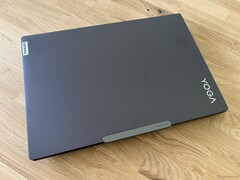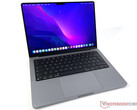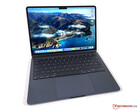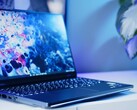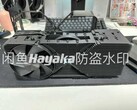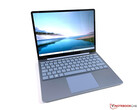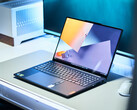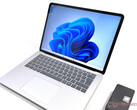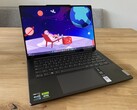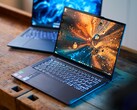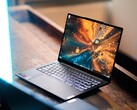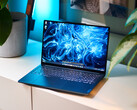Lenovo's new Yoga Pro 9i wants to be the best powerful 14-inch laptop out there. The basic recipe of the manufacturers right now is pretty similar, because all of them combine Intel Raptor Lake chips (H45 series) with Nvidia's new RTX 4000 Laptop GPUs. They are usually combined with IPS or OLED screens, but Lenovo now follows the example of the Apple and offers the new Yoga Pro 9i 14 with an optional high-resolution Mini-LED screen, which even has a high frequency of 165 Hz.
Lenovo also has some advantages in terms of the chassis and the connectivity: You get more maintenance options, the chassis quality itself is very comparable and the Yoga does not only include regular USB Type-A ports but als a superior 5 MP webcam. We also slightly prefer the keyboard of the Yoga, even though the clickpad is a bit worse compared to the MBP 14.
The display itself also reveals some differences, which are also connected to the HDR handling of the operating system. The HDR implementation of the MacBook Pro 14 is pretty much perfect, because MacOS simply recognizes HDR contents and then increases the brightness to 1600 nits (~1100 nits for a full-screen). The brightness is limited to 500 nits for SDR contents, but the Mini-LED backlight is always active, which means you always get deep and rich blacks similar to OLED screens, but also blooming.
Windows uses the SDR mode by default and is not very clever when it comes to HDR contents, because you have to activate the HDR mode in the settings first. Lenovo uses this behavior and implements to different modes for the Yoga Pro 9i. The 14.5-inch screen is used without the Mini-LED backlight control in SDR mode, so it is basically a regular LED panel and comparable to an IPS panel, for example. Therefore, the panel cannot display true black and there is also some backlight bleeding along the edges. The picture quality is still superior to regular IPS panels (especially in terms of contrast). Once you activate the HDR mode, the Mini-LED panel behaves as expected with rich blacks, but also blooming. We were quite surprised that Lenovo managed to eliminate PWM flickering when the display brightness is above 70 %. Below that, we measure between 3.8 and 17 kHz, which is not comparable to traditional PWM and the vast majority of users should not have any issues. The Yoga has an advantage in terms of brightness since we still measure almost 1400 nits on a completely white screen. Current OLED panels on the market clearly fall behind since they usually only manage around 350 nits with SDR contents and up to 600 nits with HDR contents.
The Yoga also offers plenty of performance and even offers features like Advanced Optimus, which is usually reserved for gaming laptops. You can even upgrade the GPU all the way to the RTX 4070 Laptop, which is operated at up to 80 Watts (similar to the RTX 4050 Laptop), which means the emissions should be comparable. The biggest weakness of the Yoga is the battery runtime when you use high brightness levels. We managed to empty the battery with the maximum SDR brightness in three hours during our Wi-Fi test. The results are more competitive at 150 nits with 8-9 hours, at least compared to Windows rivals, but the MacBook Pro 14 is far superior in this regard with 13.5-15.5 hours at 150 nits.
The MacBook Pro 14 is the better laptop when you primarily use apps that were optimized for Apple's silicon, if you need longer battery runtimes, if you already use other Apple products and if you have no problems with Apple's upgrade prices as well as the lack of maintenance options. The Yoga on the other hand is the better choice if you also want to use your laptop for gaming, use regular USB Type-A ports and still want some upgrade options. Both devices offer great displays and sound systems. Please see our full review of the Yoga Pro 9i 14 for more information:


